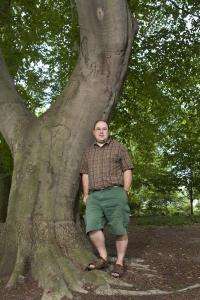For the love of trees: Book tells all about forest hydrology, biogeochemistry

Delphis (Del) Levia, associate professor of geography at the University of Delaware, has always loved trees. Growing up on his parents' 93-acre farm in central Massachusetts, he and his brothers and sisters played in the woods all the time, under the towering American beech, sugar maple and oak trees.
As a freshman in college, he originally thought he would pursue a career involving another type of "green" as a financial adviser. But then he took his first course in forest hydrology and became instantly rooted in learning more about this science, which requires extensive knowledge of both trees and the planet's water system to address such issues as the protection of watersheds for drinking water supplies.
Recently, the energetic Levia put his passion to the page, as editor of the new book Forest Hydrology and Biogeochemistry: Synthesis of Past Research and Future Directions. Published in June by Springer in its distinguished Ecological Studies Series, the 740-page hardcover book has 75 contributors from 14 countries and is designed to serve as a comprehensive one-stop reference tool for researchers and practitioners internationally.
Co-edited by geographer Darryl Carlyle-Moses from Thompson Rivers University in British Columbia and forest hydrologist Tadashi Tanaka from the University of Tsukuba in Japan, the book has 36 chapters that cover everything from novel sampling techniques, to hydrological analyses by ecoregion and forest type, to the impacts of insects, ice storms, global change and more. In identifying research needs, the book also charts the future research agenda for the field.
Levia assembled teams of promising younger scholars and esteemed pioneers to co-author many of the chapters. Among the authors is Shreeram Inamdar, associate professor of bioresources engineering at UD, who is working with Levia to assess human impacts on local forests as part of the Christina River Basin Critical Zone Observatory, a National Science Foundation program led by Donald Sparks, S. Hallock du Pont Chair of Plant and Soil Sciences and director of the Delaware Environmental Institute at UD. Ethan Frost and John Van Stan, two of Levia's doctoral students, also co-authored chapters.
Levia notes that forests are critical to future water supplies -- approximately 80 percent of the freshwater resources in the United States currently originate in forests. He says that forest hydrologists can help manage forests to maximize water supplies for the future.
"Take for instance the Boston area, which has been growing and growing, and tapping water farther and farther west," Levia says, noting that his grandmother was from Dana, Mass., one of four towns that were flooded to make way for the Quabbin Reservoir, which was built in the 1930s to help supply water to the city.
"To maximize the water available to people, you could, for example, advocate planting deciduous trees instead of conifers because less precipitation evaporates and transpires from the leaves and stems of deciduous trees, yielding more water for streams," he says. "So maple trees would be better to plant than pine trees in that area. There are strategies you can take to protect forests and water supplies."
Provided by University of Delaware
















